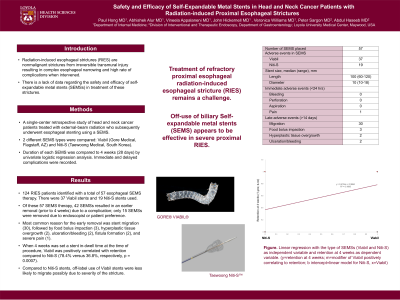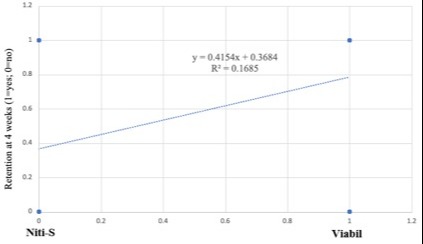Tuesday Poster Session
Category: Interventional Endoscopy
P3694 - Safety and Efficacy of Self-Expandable Metal Stents in Head and Neck Cancer Patients with Radiation-Induced Proximal Esophageal Stricture
Tuesday, October 24, 2023
10:30 AM - 4:00 PM PT
Location: Exhibit Hall

Has Audio

Paul P. Hong, MD
Loyola University Medical Center
Chicago, IL
Presenting Author(s)
Paul P.. Hong, MD, Abhishek Alur, MD, Vineela Appalaneni, MD, John C.. Hickernell, MD, Veronica Williams, MD, Peter Sargon, MD, Abdul Haseeb, MD
Loyola University Medical Center, Maywood, IL
Introduction: Radiation-induced esophageal strictures (RIES) are nonmalignant strictures which stem from an irreversible transmural injury with features of complex esophageal narrowing and high rate of complications when intervened. There is a lack of data regarding the safety and efficacy of self-expandable metal stents (SEMSs) in treatment of these strictures. Furthermore, the optimal duration of SEMSs in RIES has not been established.
Methods: A single-center retrospective study was performed to identify head and neck cancer patients treated with external-beam radiation from 2012-2022. Patients who subsequently developed esophageal strictures and underwent esophageal stenting using a SEMS were included. Two different SEMS types were used: Viabil (Gore Medical, Flagstaff, AZ) and Niti-S (Taewoong Medical, South Korea). Duration of each SEMSs was compared to 4 weeks (28 days) by univariate logistic regression analysis. Immediate and delayed complications were recorded.
Results: 124 RIES patients were identified with 23 patients receiving esophageal SEMS therapy. A total of 57 SEMS placements were performed with 37 Viabil stents and 19 Niti-S stents. 42 SEMSs resulted in an earlier removal (prior to 4 weeks) due to a complication; only 15 SEMSs were removed due to endoscopist or patient preference. Most common reason for the early removal was stent migration (30), followed by food bolus impaction (3), hyperplastic tissue overgrowth (2), ulceration/bleeding (2), fistula formation (2), and severe pain (1). When 4 weeks was set a stent in-dwell time at the time of procedure, Viabil was positively correlated with retention compared to Niti-S (78.4% versus 36.8%, respectively, p = 0.0007).
Discussion: Treatment of persistent proximal esophageal RIES remains a challenge. Stent migration was the most common complication which necessitated an earlier removal. Compared to Niti-S stents, off-label use of Viabil stents were less likely to migrate possibly due to severity of the stricture. Off-label use of biliary SEMS appears to be effective in severe proximal RIES.

Disclosures:
Paul P.. Hong, MD, Abhishek Alur, MD, Vineela Appalaneni, MD, John C.. Hickernell, MD, Veronica Williams, MD, Peter Sargon, MD, Abdul Haseeb, MD. P3694 - Safety and Efficacy of Self-Expandable Metal Stents in Head and Neck Cancer Patients with Radiation-Induced Proximal Esophageal Stricture, ACG 2023 Annual Scientific Meeting Abstracts. Vancouver, BC, Canada: American College of Gastroenterology.
Loyola University Medical Center, Maywood, IL
Introduction: Radiation-induced esophageal strictures (RIES) are nonmalignant strictures which stem from an irreversible transmural injury with features of complex esophageal narrowing and high rate of complications when intervened. There is a lack of data regarding the safety and efficacy of self-expandable metal stents (SEMSs) in treatment of these strictures. Furthermore, the optimal duration of SEMSs in RIES has not been established.
Methods: A single-center retrospective study was performed to identify head and neck cancer patients treated with external-beam radiation from 2012-2022. Patients who subsequently developed esophageal strictures and underwent esophageal stenting using a SEMS were included. Two different SEMS types were used: Viabil (Gore Medical, Flagstaff, AZ) and Niti-S (Taewoong Medical, South Korea). Duration of each SEMSs was compared to 4 weeks (28 days) by univariate logistic regression analysis. Immediate and delayed complications were recorded.
Results: 124 RIES patients were identified with 23 patients receiving esophageal SEMS therapy. A total of 57 SEMS placements were performed with 37 Viabil stents and 19 Niti-S stents. 42 SEMSs resulted in an earlier removal (prior to 4 weeks) due to a complication; only 15 SEMSs were removed due to endoscopist or patient preference. Most common reason for the early removal was stent migration (30), followed by food bolus impaction (3), hyperplastic tissue overgrowth (2), ulceration/bleeding (2), fistula formation (2), and severe pain (1). When 4 weeks was set a stent in-dwell time at the time of procedure, Viabil was positively correlated with retention compared to Niti-S (78.4% versus 36.8%, respectively, p = 0.0007).
Discussion: Treatment of persistent proximal esophageal RIES remains a challenge. Stent migration was the most common complication which necessitated an earlier removal. Compared to Niti-S stents, off-label use of Viabil stents were less likely to migrate possibly due to severity of the stricture. Off-label use of biliary SEMS appears to be effective in severe proximal RIES.

Figure: Linear regression with the type of SEMSs (Viabil and Niti-S) as independent variable and retention at 4 weeks as dependent variable. (y=retention at 4 weeks; m=modifier of Viabil positively correlating to retention; b intercept=linear model for Niti-S, x=Viabil)
Disclosures:
Paul Hong indicated no relevant financial relationships.
Abhishek Alur indicated no relevant financial relationships.
Vineela Appalaneni indicated no relevant financial relationships.
John Hickernell indicated no relevant financial relationships.
Veronica Williams indicated no relevant financial relationships.
Peter Sargon indicated no relevant financial relationships.
Abdul Haseeb indicated no relevant financial relationships.
Paul P.. Hong, MD, Abhishek Alur, MD, Vineela Appalaneni, MD, John C.. Hickernell, MD, Veronica Williams, MD, Peter Sargon, MD, Abdul Haseeb, MD. P3694 - Safety and Efficacy of Self-Expandable Metal Stents in Head and Neck Cancer Patients with Radiation-Induced Proximal Esophageal Stricture, ACG 2023 Annual Scientific Meeting Abstracts. Vancouver, BC, Canada: American College of Gastroenterology.
